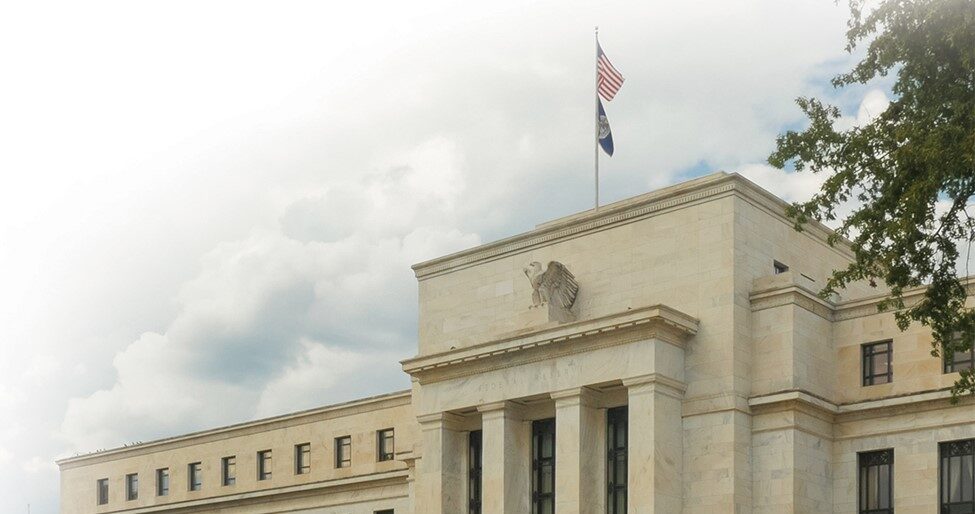This article first appeared in May’s print edition of Business Monthly.
Since mid-2023, the U.S. Federal Reserve has kept inflation rates below 4%, down from an all-time high of 9.1% in June 2022, by raising its benchmark interest rate from 0.25% in March 2022 to 5.5% since August. “The [Fed] has done an excellent job bringing down inflation,” Forbes Advisor Wayne Duggan said in a January op-ed.
However, the Fed faces a new dilemma in 2024 and beyond. Should it raise the interest rate to force inflation closer to the Fed’s 2% target, risking stagnation or even recession, where GDP shrinks in two consecutive quarters as borrowing costs increase and spending decreases? Or should the Fed cut the rate to protect GDP growth at the risk of higher inflation.
The Fed is in no rush to change its monetary policy because America’s GDP remains strong. Data aggregator Trading Economics shows the U.S. economy matching its pre-COVID-19 quarterly growth pace, hovering between 2.1% and 6.2% since the fourth quarter of 2020. The exception was the first half of 2022, when the U.S. economy shrank, resulting in a temporary recession.
Another factor influencing Fed monetary policy decisions will be global geopolitical events in southern Europe, the Red Sea and Middle East, given that the United States is the world’s second biggest trading nation.
Starting point
The Fed prefers using the personal consumption expenditures (PCE) price index when measuring inflation. The “core” version excludes energy and food prices because they are typically dictated by external factors. Trading Economics shows a gradual drop in the PCE Index from 7.12% in June 2022 to 2.45% in February.
That contrasts with the more popular consumer price index (CPI), which data curation platform Trading Economics shows reached 9.1% in June 2022, dropping to 3.2% in February.
CPI has a smaller basket of goods and services than PCE. “For example, PCE includes the price of all medical goods and services purchased by employer-provided insurance as well as public programs such as Medicare,” said a September blog published on the White House website. “CPI … only includes medical items purchased out-of-pocket by [urban] households.”
The blog also noted “the two sometimes take different approaches to measuring the same item.” PCE “also weighs [some] items differently than CPI,” the White House blog said. “Housing makes up 33% of the CPI basket, but only 15% of PCE.”
Accordingly, when PCE is lower than the CPI, it “implies that it gives less weight to prices that have been growing more quickly in the CPI,” the White House blog explained.
Another feature of U.S. inflation is that “certain segments of the economy are responding extremely well to higher interest rates [i.e., prices are going down], but others [are] proving to be problematic,” Duggan said.
Housing is one of the “stubborn” sectors. Prices increased 6.5% in November compared to a year earlier. Food is another, as prices were up 2.9% in the same period.
Wage growth also has helped fuel inflation by increasing disposable income. It grew 4%, outpacing PCE and CPI inflation rates. That “offsets the impact of higher prices for many consumers,” said Duggan, leading to more consumer spending.
On the other hand, energy prices decreased. From November 2022 to November 2023, consumer prices were down 5.4%. “Gasoline prices were down 8.9% year-over-year in November and 6% compared to October,” Duggan said. Fuel oil saw a 24.9% drop from November 2022 to November 2023, while natural gas prices decreased 10.4% in the same period.
Forecasts 2024
In the first quarter of 2024, CPI and PCE inflation followed similar trajectories. CPI inflation fell 0.4% in January compared to December 2023. It then increased month-on-month by 0.3% in February and March. PCE dropped 0.2% from December to January but rose by 0.02% in February versus January. PCE March figures weren’t available at press time.
That is the opposite of what happened in 2023. CPI inflation rates started the year by dropping 0.1% from December 2022 to January 2023. In February 2023, it fell by 0.4% compared to January 2023, while March 2023’s CPI inflation decreased by 1% compared to February 2023.
PCE rose slightly from December 2022 to January 2023 (nearly 0.04%) but dropped by 0.3% in February 2023 versus January 2023 and 0.7% in March 2023 compared to February 2023.
In April, Fed Chairman Jerome Powell told the media inflation in 2024 would remain high “longer than expected.”
Nevertheless, the Fed expects inflation to decrease by the end of the year. The Federal Open Market Committee’s official forecast published in January said inflation would decrease from 3.2% in 2023 to 2.4% in 2024.
That aligns with a January survey of market experts published by the Federal Reserve Bank of St. Louis and Goldman Sachs, which said inflation would drop to 2.5% and 2.4% by the end of 2024. “The auto, labor, and housing rentals markets [would] spearhead the disinflation,” Goldman Sachs said.
That is not good news for local industry, as prolonged elevated inflation means interest rates will take longer to drop from the current 5.5% toward near-zero levels pre-pandemic. Speaking to AP News in March, Micheal Pearce, an economist at Oxford Economics, said, “A June rate cut now looks more likely than the May cut we … previously expected.”
Peterson Caldwell, a senior U.S. economist at Morning Star, a think tank, expects the Fed to cut interest rates from the current 5.5% to between 4% and 4.25% by the end of 2024. However, the Fed’s “dot plot,” a graph showing expert expectations, predicts rates will be 4.6% by the end of 2024.

Forecasts 2025/2026
According to Duggan, if 2024 projections are correct, 2025 will have a new problem to tackle: “sticky inflation,” which is the “final phase of the [Fed’s] war on inflation.”
The sectors to look out for include children’s clothing, auto insurance, medical care products, rent and public transportation, as they “can be slow to respond to monetary policy adjustments,” Duggan said.
Yun Li, a reporter for CNBC, said in December that interviewed market experts forecast the core PCE Price index would drop to 2.2% in 2025 from the forecasted 2.4% in 2024. They align with the Fed’s December 2023 expectations that core PCE will fall to 2.3% in 2025 from a forecasted 2.6% in 2024.
Even though inflation will not reach the Fed’s 2% target in 2025, Caldwell expects interest rates of 2.5% to 2.75% by year’s end, down from a forecasted 4% to 4.25% in 2024. That contrasts with the March Fed’s Summary of Economic Projections (SEP), which expects interest rates to reach 3.9% in 2025.
The following year could be a breakthrough year for the U.S. economy as the Fed could finally reach its core PCE inflation target of 2% in 2026, Li reported.
Caldwell said that between 2024 and 2028, the “average” annual inflation rate should drop below the Fed’s target, reaching 1.9%. “The continual downtrend in inflation will be owed greatly to the unwinding of price spikes as supply constraints ease and the pace of economic growth slows.”
Accordingly, interest rates should drop further, though none of the projections put it at the pre-pandemic’s near-zero levels. The March SEP report forecasts interest would only fall to 3.1% in 2016, down from 3.9% in 2025.
The Fed dot plot graph shows experts anticipating three interest rate reductions in 2026 to bring interest rates between 2% and 2.25%. Caldwell of Morning Star is more optimistic, forecasting interest rates between 1.75% and 2% by the end of 2026. “After that, the Fed will be done cutting,” he said.
Global effects
U.S. inflation and interest rates are noticeably affected by global inflation, as the country is a historic net importer of goods and services. According to the World Bank, the world’s biggest economy saw imports as a percentage of GDP reach a seven-year high in 2022 (15.6% of GDP).
A January IMF research note highlighted the diverse array of global inflation’s “upside” and “downside” risks across developed and emerging economies until 2026.
The report said “upside risks” include “faster-than-expected” drops in inflation in many advanced and emerging markets. That would be due to “stronger-than-expected pass-through from lower fuel prices, further downward shifts in the ratio of vacancies to unemployed [individuals] and a compression of profit margins to absorb past cost increases.”
Additionally, some governments may be reluctant to withdraw fiscal support from their respective economies, “implying higher than projected global growth in the near future,” the IMF said. That could “exacerbate inflation and, with elevated public debt, result in higher borrowing costs and a more disruptive policy adjustment.”
The IMF report also noted China, third-biggest trading partner of the United States, could see its GDP recover faster than expected. That would mean higher global inflation as its imports increase to meet booming local demand. According to the World Bank, China is the world’s second-biggest importer of goods and services.
Other sources of global inflation that could affect the U.S. include “commodity price spikes amid geopolitical and weather shocks,” the IMF note said. “The conflict in Gaza and Israel could escalate further into the wide region, which produces 35% of the world’s oil exports and 14% of gas exports.”
That conflict also impacts cargo traffic in the Red Sea, which accounts for “11% of the world’s trade flows — and the ongoing [war] in Ukraine risks generating fresh adverse supply shocks to the global recovery, with spikes in food, energy and transportation costs,” the IMF said.
An OECD paper from February estimates the impact of such disruptions will last 18 to 20 months. “We expect inflation to be back to central bank targets by the end of 2025 in most G20 economies,” the report said.
However, governments should not quickly decrease interest rates to fuel GDP growth. “Monetary policy should remain prudent,” the OECD report said. “Central banks could start to lower interest rates this year, provided … inflation continues to ease.”







